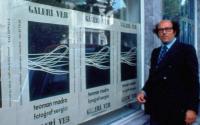Common Dreams / Published on Wednesday, January 28, 2004 by the Seattle Post-IntelligencerLewis Kamb
Howard Lyman remembers his days as a Montana cattleman, a fourth-generation rancher who raised some 30,000 cattle for slaughter at a farm and feedlot southeast of Great Falls.
He also remembers what his cows ate -- and the popular notion that cattle spend their lives grazing in green pastures is far from reality, Lyman says.
"When I was a kid, you raised your cows on mother's milk," the 65-year-old Lyman said. "Then as they'd get older, they'd graze most the year and winter on hay."
But that's not how it happens now -- and hasn't for a long time.
Ranchers found that grain rations mixed with proteins could help fatten and muscle out herds more quickly, and in turn, bring mature livestock to market much faster, Lyman said.
And, in farming communities, a variety of protein sources were readily available, from soybeans or peanuts or cottonseed. Or, from chicken feces, poultry feathers, cow blood or other parts of pigs, horses, fish, cattle and just about any animal part unfit for human consumption.
"These days, anytime you find an animal raised in a factory feedlot setting, they're all eating rendered animal parts." Lyman said. "I was told this was the new modern way to do it. I bought into it hook, line and sinker. And I was wrong."
Six-and-a-half years ago, the federal government announced such feeding practices were wrong, too -- at least partially.
In 1997, the Food and Drug Administration -- acting to safeguard America's beef against a disease emerging overseas called mad cow -- banned cattle feed from containing most byproducts of cattle, sheep and goats.
The prevailing thinking among scientists is the fatal brain-wasting disease -- thought to be transmitted to humans who eat tainted beef -- can infect cows eating feed contaminated by proteins rendered from diseased cows and possibly other ruminants.
This week -- about a month after the first mad cow case emerged on American soil, in Yakima County -- the FDA went further, announcing new restrictions on cattle feeds, including bans against cattle blood and poultry litter, which includes manure.
Still, some food safety activists say the beefed-up feed ban doesn't go far enough.
Cows are still allowed to eat feeds that can include parts of pigs, fish, chicken, horses, even cats or dogs. And some of those animals -- before being rendered and mixed up for cattle feed -- are raised on food containing the same cow parts now banned from cattle consumption.
And cattle can continue to consume pig and horse blood for protein, as well as tallow, a hard fat from rendered cattle parts, as a fattening source.
That's not good enough for some activists, such as Lyman, who favors an all-out ban on any animal ingredient in cattle feed. Lyman gave up his feedlot in 1983 and later became an outspoken critic of the beef industry.
Turning herbivores such as cows into carnivores and cannibals is likely what caused the problems in the first place, critics contend.
But government scientists and industry officials say nothing proves it's necessary to take such drastic steps. While many European countries now impose such all-out feed bans, those nations did so in response to a mad cow epidemic -- not a single infected cow, like in America; and not one thought to have become infected before this country's 1997 feed ban.
"No science at this point tells us that pigs and chickens and horses spread" mad cow disease to cattle that eat parts of such animals, said Dr. Murray Lumpkin, principal associate commissioner of the FDA. "If you can't support it in the science, it's hard to give reasons why you would keep these things out of feed."
But in the ever-evolving world of bovine spongiform encephalopathy -- a disease still scientifically fuzzy and highly debated -- one thing is clear: Food deemed safe for cows today can be banned tomorrow.
Dairy and beef cattle generally are raised on the same feed sources, experts say, but the rationing of such feed differs for each type of cow.
Though cows spend much of their lives eating grass and other forages, such as alfalfa and hay, some industry insiders say diets largely changed after World War II -- when the bottom dropped out of the grain market.
Cattle ranchers then widely turned to cheap and available sources of feed that could help fatten herds more quickly, and in turn, help bring mature livestock to market faster.
And with advances in cattle genetics, they found grain rations mixed with fats and proteins could optimize their cows' respective products marketed for consumption: beef and milk.
While soybeans, cottonseed and synthetic amino acids increasingly have been used for such protein supplements, animal byproducts remain widespread. Everything that swims, flies, snorts, even purrs or barks, can be -- and has been -- used as protein in cattle feed, industry officials acknowledge.
"That's just the beauty of the rendering process," said Tom Cook, president of the National Renderers Association, a lobbying group for the rendering industry. "It takes material that's generally useless and adds value back into that material."
In the United States, about 50 billion pounds of dead animals are processed each year in about 265 commercial and independent rendering plants. Animal parts are first sent through a grinding machine, before being cooked at temperatures of 270 to 300 degrees for up to an hour, Cook said.
"That kills just about all bacteria or viruses," Cook added, "except we recognize that prions aren't necessarily destroyed in that process."
In fact, prions -- the misfolded proteins that some scientists think cause mad cow disease and other transmissible spongiform encephalopathies (TSEs) -- have been known to withstand temperatures of 1,000 degrees or more, some studies say.
Since the FDA's 1997 feed ban, cow brains, spinal cords and other central nervous system tissues -- cattle parts where prions are typically harbored -- are removed, separately rendered and kept out of cattle feed. Any feed mix for other animals containing such parts is supposed to be labeled, "Do not feed to cattle or other ruminants."
Yet, even Cook acknowledges "there's never an absolute" in the rendering business. Prohibited cattle feed "can get mixed up at the (rendering) plant," or in feed mills, ranches and other facilities where mixing takes place, he said.
With prohibited byproducts still being rendered and fed to animals other than cattle, there is no absolute guarantee such contamination won't happen somewhere in the process.
"Accidental" feed contamination is what most worries Judd Aiken, a biologist who studies prion diseases at the University of Wisconsin-Madison
The only sure way to guard against accidentally feeding poultry- or pig-feed to cattle on the farm, Aiken said, is "don't allow any ruminant meat into other feed. If there's any potential that it could wind up in cattle feed," he said, "we just can't do it."
Speaking before the FDA's new feed regulations were issued, Aiken suggested such accidental feeding poses much higher risks than other feed "loopholes" the federal agency sought to close this week.
The new restrictions not only prohibited cow blood meal as an ingredient of calf milk-replacers -- a widespread feed source for dairy and veal calves -- but also banned chicken and turkey litter from cattle feed, which some ranchers used as a cheap feed protein.
Still, nothing now restricts chickens, turkeys, pigs, horses and other animals from eating rendered cow parts -- and later being rendered and fed back to cattle.
Scientists say it's not clear whether TSE diseases, particularly mad cow disease, can readily cross the "species barrier" in that manner -- passing from an infected animal in one species to a different animal that consumes it.
Some scientists theorize Britain's mad cow outbreak in the 1990s occurred when cows ate feed containing parts of sheep and goats infected with scrapie -- a prion disease long known to infect those ruminants.
"The science of this (disease) is clearly an evolving issue," Lumpkin said. "I wouldn't say (the latest feed restrictions) are the end. ... If we need to make further changes, we will."
But to some activists, such as Howard Lyman, the bottom line remains the same: "We still feed animals to cows," he said
And that's exactly why the former rancher became the so-called "Mad Cowboy" -- the man who rose to recognition by criticizing the safety of U.S. beef, and who, with Oprah Winfrey, was unsuccessfully sued by ranchers for such criticism.
It's also why Lyman now swears off eating meat.
"I eat nothing with a face, a liver or a mother," he said. "And I tell you what, I'm one of the happiest people alive."






